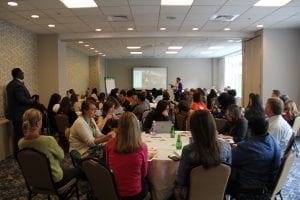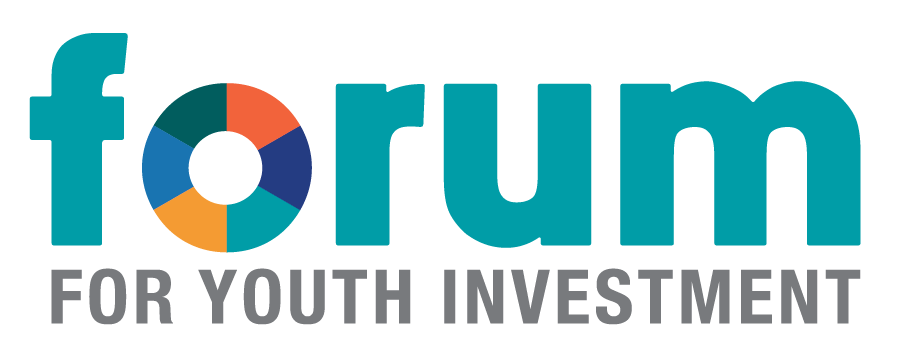The submission deadline has passed.
At the core of the Ready by 21 National Meeting are the workshops that educate and inspire the hundreds of leaders in attendance to do the ground work in ensuring that all young people are ready to succeed. Our workshops are designed to provide varying levels of content and presentation formats in order to better equip communities of all shapes and those in various stages of change.


We invite you to submit a session proposal for consideration by COB, Friday, November 1, 2019. Approximately 45 Workshops will be offered during one of four 75-minute periods on April 16 and 17. In addition, approximately 25 applicants will be selected to kick off shorter, 25-minute roundtable discussions with short presentations. Applicants will receive notification of their standing by early January.


The National Meeting offers keynotes, plenary sessions, workshops, peer learning circles and abundant networking opportunities, all built around big and common challenges, such as how do we:
- Ensure Readiness for college, work, and life, by building competencies, abilities, and mindsets.
- Promote Equity for all young people, especially closing gaps for populations often facing great challenges (e.g., boys & young men of color, opportunity youth, youth in foster care, pregnant & parenting youth) and creating equitable learning environments for all.
- Increase Shared Commitment to changing the odds for young people through common goals, strategies, and measures within and across systems & sectors.
- Improve Program Quality and effectiveness in ways that spark management & staff engagement and support better outcomes for young people.
Please find below some helpful guidance as to what content and types of sessions we are seeking. Themes Each year, our National Meeting is built around the Forum’s four big themes, outlined above. Which of these would your workshop primarily and secondarily address? Some of the specific questions Ready by 21 leaders across the country have posed to us this year are included below each theme. We are also interested in receiving proposals that speak to questions like these or others you have raised or been asked. As you review the list, you’ll see that many of the questions straddle the themes. This is good. Starting with a question helps you focus your presentation and lets participants know what to expect.
Ensuring Readiness
- How many young people are “ready” for college, work, life?
- Are there new studies or data sets?
- What are the differences in readiness across subpopulations?
- How can local communities come up with “readiness indicators” beyond graduation rates?
- What influences readiness? What’s the same/different across age groups? Across neighborhoods? What do we know that we can use?
- How are different systems (e.g., K-12, youth development, child welfare, juvenile justice, health, employment) defining and measuring child and youth readiness?
- What are the existing policy opportunities (e.g., ESSA)? What are the challenges? What policy agendas should be advanced in support of readiness? Do their policies and practices support readiness?
- How are leaders dealing with the proliferation of frameworks and measures being developed within systems and across systems? Are there crosswalks? Generic models? How do we find common language?
- How does the new research on brain science, trauma, and learning help inform our thinking about development and skill-building? How does this fit with the other frameworks around readiness?
- What knowledge, skillsets, and mindsets do young people and families value? How are young people and families being actively involved in defining and improving readiness?
- Is there evidence that we can improve skills and competencies, even in adolescence?
Promoting Equity
- What are the gaps? How do we best help leaders know what they are?
- How and where are young people and their families being empowered to understand, resist and reduce inequities in their lives and communities? Where are they actively involved in designing and/or implementing solutions or interventions?
- What do practitioners and decision-makers need to understand about marginalized youth populations in order to better support them? How is this information best conveyed? How does it get baked into practice and decision-making?
- What are examples of successful practices, programs, partnerships and policies? How were they developed? How can they be leveraged?
- How do organizations engage with systems-level work proactively when most of their work is previously at the program level?
- What does “promoting equity” mean? Is equity a noun? A verb? Is it a goal? A process? A lens? How can groups be sure they are really addressing and advancing equity?
- How do we define and promote equitable learning environments? How do we build the capacity of the adults that shape the experiences of children and youth wherever they spend their time?
Improving Program and Practice Quality
- Why does the quality of the learning environment matter? Can we demonstrate the impact of context on youth’s ability to build skills and master content? How?
- Why focus on adult practice? How does practice influence overall program quality? If we’ve adopted an evidence-based program or curriculum, do we need to assess practice? Isn’t training enough?
- What comes before quality improvement? Are all programs and organizations ready to tackle quality?
- Are all elements of program quality universal? How are we helping practitioners and programs be culturally responsive?
- What does it take to build a Quality Improvement System? Who plays this role in communities and states? What does it take to fund a QIS? Sustain it? Demonstrate its value?
- What are the common components of effective programs? Are there ways to build these into existing programs? What’s working? Lessons from across systems (e.g. health care, juvenile justice, education)?
- How can programs take an evidence-based decision-making approach? How do funders support evidence-based decision making?
- How can schools and other organizations or systems that use high-stakes staff assessments that are often linked to youth outcomes and behaviors shift to a lower-stakes assess-plan-improve approach?
- Does good program quality = good SEL skill growth? Is there room to for improvement? How?
- Does adult practice transfer across settings? What can be done to encourage cross-training?
- Where does quality measurement fit on an organization or networks performance dashboard?
Increasing Shared Commitment
- What are some of the big ideas (backed up with evidence) that help diverse groups of leaders think differently about readiness, equity, quality? (e.g. changing the odds, whole child education, trauma-informed care, social brain) How can we use them?
- How are leaders taking these ideas into their spheres of influence? What does it take to change thinking and get new ideas into the water? Are there strategies that can be used? How can we use implementation science to inform our work?
- Have collective impact initiatives had an impact? What lessons have been learned?
- What does it take to partner for impact? When the organizations or systems are very different, how do we help each partner better understand the context or realities of how they are different as they negotiate common ground?
- How can the Opportunity Index, the Kids Count Indicators, and other standardized measures of community progress be better used? What supports are needed locally or nationally to encourage or sustain use?
- What are the through stories that spark change? What are the common themes around people, politics, places and/or policies? How are communities linking outcome goals to opportunity goals to leadership commitments?
- Where’s the funding to support a broad vision of child and youth success? Are there more efficient ways to map funding across programs and systems? Align or redirect available funds? Generate new funding? Are communities having success?
- How can leaders incorporate youth voice and leadership into their decision making?
Learning Objectives
- What question are you helping participants answer? (Why … How… When… What if…)
- What type of information are you conveying (introductory overview, your latest research, case example (s), demonstration of tool or approach applications)? How?
- What will participants take away that they can use?
